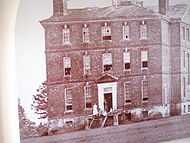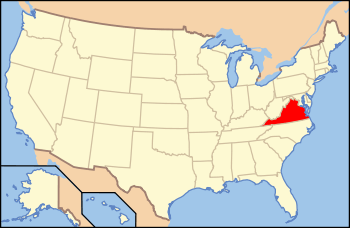Rosewell (plantation)
|
Rosewell | |
|
| |
|
Ruins of Rosewell. | |
 | |
| Location | Rosewell, HABS Photo |
|---|---|
| Coordinates | 37°19′40″N 76°34′35″W / 37.32778°N 76.57639°WCoordinates: 37°19′40″N 76°34′35″W / 37.32778°N 76.57639°W |
| Area | 9.9 acres (4.0 ha) |
| Built | 1725 |
| Governing body | Private |
| NRHP Reference # | 69000244[1] |
| VLR # | 036-0041 |
| Significant dates | |
| Added to NRHP | October 1, 1969 |
| Designated VLR | November 5, 1968[2] |
Rosewell Plantation in Gloucester County, Virginia, was for more than 100 years the home of a branch of the Page family, one of the First Families of Virginia. Begun in 1725, the Flemish bond brick Rosewell mansion overlooking the York River was one of the most elaborate homes in the American colonies. In Mansions of America, the architectural historian Thomas Tileston Waterman described the plantation house as "the largest and finest of American houses of the colonial period."[3] Through much of the 18th century and 19th centuries, and during the American Civil War, Rosewell plantation hosted the area's most elaborate formal balls and celebrations. The home burned in 1916.
History

The building of Rosewell was begun in 1725 by Mann Page I (1691–1730), who married in 1718 Judith Carter, the daughter of Robert Carter I. Educated at Eton College and Oxford University in England, Mann Page was appointed to the Governor's Council of the Virginia Colony shortly after his return to Virginia. He embarked on construction of Rosewell in 1725, but died five years later before construction was completed.
It was Page's intention to build a home that would rival or exceed the newly completed Governor's Palace in Williamsburg in size and luxury. When Mann Page I died five years into construction on the home, the property passed to his wife Judith.[4] The primary construction materials were brick, marble and mahogany, some of which was imported from England. Architectural historians believe that the 12,000-square-foot (1,100 m2) house, double the size of the Governor's Palace, may have been designed by Mann Page himself. Larger than any home built in colonial Virginia, Rosewell probably owed its design to the London townhouses built to the stricter codes following the Great Fire of London.[5]
Their son Mann Page II saw the unfinished mansion through to completion after the elder Page's early death.[6] By then the Page family was strapped for cash due to the cost of building the great house, and Mann Page II ultimately sold off a significant portion of his vast land holdings to fund its completion.
Like many plantations in the South, Rosewell fell into disrepair following following the Civil War. The rooftop cupolas were removed from the dilapidated mansion and its lead roof was stripped off and sold as was much of its fine interior woodwork. The Rosewell Mansion was destroyed by fire in 1916. Today, a largely undisturbed historic ruin, the site has been the subject of archaeological work which has revealed many artifacts and shed light on some aspects of colonial life and architecture previously unclear.
Page family of Virginia

Governor of Virginia John Page (1743–1808) was the grandson of Rosewell's first owner, Mann Page (I). He grew up there, and was a classmate of Thomas Jefferson at the College of William and Mary in nearby Williamsburg where he graduated in 1763. John Page fought during the American Revolutionary War, attaining the rank of colonel. He also served multiple terms in the U.S. Congress and the Virginia General Assembly. Other notable members of Virginia's Page family also include Governor Page's brother Mann Page III, his great grandfather, Colonel John Page of Jamestown and Middle Plantation, author and U.S. Ambassador to Italy Thomas Nelson Page, Virginian Railway builder William Nelson Page; United States Navy and Confederate States Navy Captain Thomas Jefferson Page, Confederate General Richard Lucian Page and Revolutionary War General Joseph Martin, the namesake of Martinsville, Virginia.
Description
Rosewell Mansion and part of its history were described by author James Joseph McDonald in "Life In Old Virginia" (The Old Virginia Publishing Co., Norfolk, Va., 1907) thus:
- "The mansion is substantially built of brick, three story and basement. The foundation walls are three and one-half feet thick. The reception hall is large, the ceilings lofty, and the whole mansion is indicative of refined taste and wealth. From the upper windows, a magnificent view is had of the surrounding level lands and the waters of the creeks and the York River.
- "During the life of Governor Page, Thomas Jefferson was a frequent and welcome visitor there. While on one of his visits he wrote the rough draft of the Declaration of Independence in what is now known as the 'Blue Room,' situated on the northwest corner of the second story of this house."
The elaborate Flemish bond brickwork, the towering three stories, and the siting of the mansion were all meant to recall elaborate London homes of the era. In that sense, Rosewell was among the most sophisticated early buildings built in America. "Rosewell was the largest and most advanced brick building in Virginia at the time," writes architectural historian Daniel Drake Reiff. "It was unique in being of London townhouse design, and it seems likely that a London bricklayer was brought over to supervise the massive undertaking and to execute the more complicated detailings in brick – like the door casings."[7] The similarity in Flemish bond brickwork between Rosewell and Christ Church built by Page's father-in-law, Robert Carter, in Lancaster County has led some to speculate that the same masons might have had worked on both.[8]
The home was also the first in the American colonies to have a projecting central pavilion, "antedating any other by a score of years," wrote architectural historian Fiske Kimball in Domestic Architecture of the American Colonies and of the Early Republic. "At Rosewell the pavilions, front and rear, are masses deep enough to affect the spaces of the interior, but a glance at the plan reveals that they were adopted for plastic exterior effect."[9]
As originally completed, the home boasted a flat lead roof behind a parapet atop its three stories, and twin octagonal cupolas at each end. Flanking dependencies in front of the mansion formed an elaborate forecourt. The interior was painted in high style, such that the restorers of Colonial Williamsburg relied, in part, on an order by John Page for paints from London to give a sense of the colors in the Governor's Palace at Williamsburg. In 1771 Page wrote to John Norton and Sons of London for new materials, appending these instructions: "As my house is very much out of repair, I shall be much obliged if you will send me the following articles: 100 lbs. white lead; 20 lbs. yellow ochre; a bri of oyl; 20 lbs. of Venetian Red; 2 gallons of spts of Turpentine; 5 lbs. of Red lead; 3 lbs. lamp Black; 2 lbs. of white Coperas."[10]
Hours
Rosewell Plantations hours of operation are as follows:
Monday – Thursday 10am-4pm
CLOSED on Fridays
Saturday 10am-4pm
Sunday 1pm-4pm
A visitors fee of 4 dollars for adults, 2 dollars for kids (12 & under), and 3 dollars for students.
For more information call: (804)693-2585
See also
References
- ↑ "National Register Information System". National Register of Historic Places. National Park Service. 2010-07-09.
- ↑ "Virginia Landmarks Register". Virginia Department of Historic Resources. Retrieved 5 June 2013.
- ↑ "Historic Rosewell Remains Touch Gloucester Resdidents". The Daily Press. 20 March 1991. Retrieved 2011-06-15.
- ↑ Matrana, Marc R. (2009). Lost Plantations of the South. Jackson, Mississippi: University Press of Mississippi. ISBN 9781604734690.
- ↑ Kornwolf, James D.; Wallis, Georgiana (2002). Architecture and Town Planning in Colonial America, Vol. 2. Baltimore, Maryland: Johns Hopkins University Press. ISBN 9780801859861.
- ↑ Notes on often-cited persons, places, and things in Robert Carter's Diary and Letters, Edmund Berkeley Jr., virginia.edu
- ↑ Reiff, Daniel Drake (2000). Houses from Books: Treatises, Pattern Books, and Catalogs in American Architecture: 1738-1950. University Park, Pennsylvania: Pennsylvania State University Press. ISBN 0271044195.
- ↑ "Historic Christ Church, Lancaster County, Virginia". Christ Church (Lancaster County, Virginia). Retrieved 2011-06-27.
- ↑ Kimball, Fiske (1922). Domestic Architecture of the American Colonies and of the Early Republic. New York: Charles Scribner's Sons. ISBN 9780486417059.
- ↑ Kocher, A. Lawrence (1952). "Architectural Report: Palace of the Governors of Virginia". Colonial Williamsburg Digital Library. Colonial Williamsburg Foundation. Retrieved 2011-06-26.
Further reading
- The Mansions of Virginia, 1706-1776, Thomas Tileston Waterman, University of North Carolina Press, Chapel Hill, North Carolina, 1946
- Some Colonial Mansions and Those Who Lived in Them, Thomas Allen Glenn, Henry T. Coates & Company, Philadelphia, Pennsylvania, 1899
- Genealogy of the Page family of Virginia, Also a Condensed Account of the Nelson, Walker, Pendleton and Randolph Families, Richard Channing Moore Page, Jenkins & Thomas, New York, 1883
External links
| Wikimedia Commons has media related to Rosewell Plantation. |
- Rosewell, Carter Creek, White Marsh, Gloucester County, VA: 11 photos and 2 data pages at Historic American Buildings Survey
- Rosewell Foundation webpage
- 'Rosewell', Thomas Jefferson's Monticello, monticello.org
- 'Rosewell - Gloucester, Virginia - Conjectural rendering', architectural rendering, Flickr
- 'Rosewell, Gloucester County, Virginia - Restored drawing', architectural rendering, Flickr
- 'Rosewell, Gloucester County, Virginia - Restored drawing', architectural rendering, Flickr
- 'Rosewell, Gloucester County, Virginia - Mansion Model, architectural model, Flickr
- 'Page Family Tombs', initially buried at Rosewell, Page family tombs were moved to nearby Abington Episcopal Church, White Marsh, Gloucester County, Flickr
- 'Page Family Tombs', Abington Episcopal Church, Flickr

